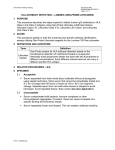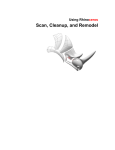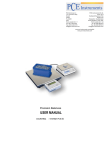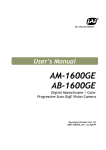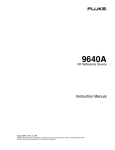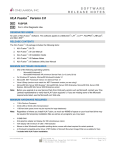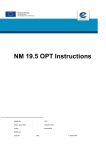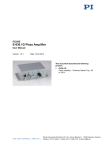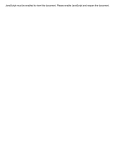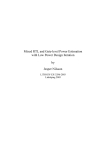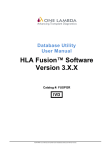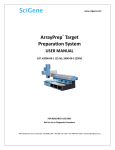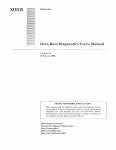Download HLA Antibody Luminex SOP OneLambda
Transcript
CTOT-HLA Antibody Testing Procedure 0001 Effective Date 02/15/11 Page 1 of 15 HLA ANTIBODY DETECTION – LUMINEX (One Lambda) 1 PURPOSE This procedure describes the steps required to perform solid phase immunoassay to qualitatively detect IgG - HLA Class I and Class II antibodies and their specificities. 2 SCOPE This procedure applies to both the screening and specific antibody identification assays utilizing One Lambda LABScreen Mixed, LABScreen PRA Class I, LABScreen PRA Class II, LABScreen Single Antigen HLA Class I and LABScreen Single Antigen HLA Class II-combination for the Luminex 100 flow cytometer. 3 DEFINITIONS AND ACRONYMS – N/A 4 RELATED PROCEDURES – N/A 5 SPECIMEN 5.1 Acceptable • 5.2 Serum separated from fresh whole blood collected without anticoagulant using aseptic technique. Store serum aliquot at 2 to 8˚C until tested or freeze at -20 to -80˚C for longer storage. Separate serum from blood cells when stored or shipped to avoid hemolysis (see also Appendix I). Unacceptable • Serum contaminated with bacteria, immune complexes or other immunoglobulin aggregates. If present, these can cause increased nonspecific binding and erroneous results. Note: Aggregates may be removed by centrifugation or filtration prior to testing. • Serum repeatedly frozen and thawed. This can weaken antibody reactivity. CTOT- sop0001.doc CTOT-HLA Antibody Testing Procedure 0001 Effective Date 02/15/11 Page 2 of 15 6 REAGENTS Reagent 70% Alcohol Formula, Vendor & Catalog Number Stock (100%): Reagent alcohol. Fisher, Cat. #A962-4, or comparable. 70%: Add 350 ml Alcohol to 150 ml Millipore water. Note: Ethyl or isopropyl alcohol may be used. Luminex. Store at 2-8˚C up to manufacturer’s expiration date. • • Calibrator and Control Microspheres • • xMAP Classification Calibration Microspheres (CAL1): Cat. #L100-CAL1. xMAP Reporter Calibration Microspheres (CAL2): Cat. #L100-CAL2. xMAP Classification Control Microspheres (CON1): Cat. #L100-CON1. xMAP Reporter Control Microspheres (CON2): Cat. #L100-CON2. Hazard Warning: Contains Sodium Azide. Use appropriate PPE and disposal precautions. Consult MSDS. PE-Conjugated Goat Anti-Human IgG, 1000 tests. One Lambda, Cat. #LS-AB2. Store in dark at 2-5°C up to manufacturer’s expiration date. Goat Anti-Human IgG Stock (100X): Reconstitute with Millipore water. Check the bottle label for the recommended volume to prepare stock. (This volume may vary lot to lot depending on the titer of antibody conjugate.) Centrifuge solution if not completely clear after standing at room temperature for 1-2 hours. Store at 2-5°C up to 6 months from reconstitution or manufacturer’s expiration date (if earlier). Working (1X): Add 1 µl 100X conjugate to 99 µl wash buffer. Prepare fresh. Store at room temperature in the dark up to 24 hours. Return unused portion of 10X conjugate to storage for future use. LABScreen® Single Antigen HLA Class I – Combi. Hazard Warning: Contains Sodium Azide. One Lambda, Cat. #LS1A04. Kit includes Class I Single Antigen Beads and 10X Wash Buffer. Store unopened kit products at or below -65°C up to manufacturer’s expiration date. Once thawed do not refreeze. Store beads and wash buffer at 2-5°C up to three months or manufacturer’s expiration date if earlier. Hazard Warning: Contains Sodium Azide. CTOT- sop0001.doc CTOT-HLA Antibody Testing LABScreen® Single Antigen HLA Class II – Group 1 LABScreen® PRA Class I LABScreen® PRA Class II LABScreen® Mixed LABScreen® Negative Control Serum Wash Buffer CTOT- sop0001.doc Procedure 0001 Effective Date 02/15/11 Page 3 of 15 One Lambda, Cat. #LS2A01. Kit includes Class II Single Antigen Beads and 10X Wash Buffer. Store unopened kit products at or below -65°C up to manufacturer’s expiration date. Once thawed do not refreeze. Store beads and wash buffer at 2-5°C up to three months or manufacturer’s expiration date if earlier. Hazard Warning: Contains Sodium Azide. One Lambda, Cat. #LS1PRA. Kit includes Class I Antigen Beads and 10X Wash Buffer. Store unopened kit products at or below -65°C up to manufacturer’s expiration date. Once thawed do not refreeze. Store beads and wash buffer at 2-5°C up to three months or manufacturer’s expiration date if earlier. Hazard Warning: Contains Sodium Azide. One Lambda, Cat. #LS2PRA. Kit includes Class II Antigen Beads and 10X Wash Buffer. Store unopened kit products at or below -65°C up to manufacturer’s expiration date. Once thawed do not refreeze. Store beads and wash buffer at 2-5°C up to three months or manufacturer’s expiration date if earlier. Hazard Warning: Contains Sodium Azide. One Lambda, Cat. #LSM12. Kit includes Class !, Class II and MICA Antigen Beads and 10X Wash Buffer. Store unopened kit products at or below -65°C up to manufacturer’s expiration date. Once thawed do not refreeze. Store beads and wash buffer at 2-5°C up to three months or manufacturer’s expiration date if earlier. Hazard Warning: Contains Sodium Azide. One Lambda, Cat. #LS-NC. 20 tests. Store frozen (20°C or below) until first usage. After thawing keep at 25°C up to 5 days. Freeze aliquots, or re-freeze the original reagent vial (1time only) if reagent is not used within 5 days. Use before manufacturer’s expiration date LABScreen® 10X Wash Buffer (13 ml bottle). One Lambda, Cat. #LSPWABUF. Already included in the kits above. Stored at or below -65 °C together with the beads up to manufacturer’s expiration date. Once thawed do not refreeze. Dilute 13 ml 10X buffer in 117 ml Millipore water to make 1X work solution. Store at 25°C up to three months or until expiration date. CTOT-HLA Antibody Testing PBS Sheath Fluid Water Procedure 0001 Effective Date 02/15/11 Page 4 of 15 10X Dulbecco’s Phosphate Buffered Saline (PBS) without Ca2+ / Mg2+. Irvine Scientific, Cat. #9242 or equivalent. Store at room temperature up to manufacturer’s expiration date. 1X PBS: Dilute 10X stock 1:10 with Millipore water. Adjust pH to 7.4. Store up to one year at 4˚C. LAB MAP Sheath Fluid. Luminex Corporation, Cat. #4050000. Store at room temperature up to manufacturer’s expiration date. Millipore Clinical Lab Reagent Water (CLRW). Deionized, purified water. 7 EQUIPMENT AND SUPPLIES 7.1 Equipment Item Analysis Software Luminex 100 Rotator Centrifuge Vortex 7.2 Vendor & Catalog Number HLA Fusion ™ Software. One Lambda, Inc. Luminex 100 IS Flow Analyzer. Luminex Corporation. Rotating platform (200 rotations per minute). Various vendors. Beckman TJ6 or comparable. Fisher Vortex Genie 2 or comparable. Supplies Item 96 well plate, Ubottom Tray Seal Microcentrifuge tubes Vendor & Catalog Number Corning, 96 wells, 330ul microplate. Cat. #3799 or equivalent. Tray Seal. One Lambda, Cat. #SSPSEA300. ISC BioExpress (Colorless tubes. Replace last digit in order number for colors: G=green, Y=yellow, O=orange): 1.6 ml, Cat. #C3300-1 or equivalent. 8 QUALITY CONTROL 8.1 Specimen preparation: Centrifuge for 5 minutes at 10,000 x g prior to testing. 8.2 Include the negative control sera with each test to determine if technical errors or reagent failures have occurred. 8.3 Daily instrument maintenance (when in use) • • • Alcohol flush to remove air bubbles from the cuvette. Check that vertical alignment of sample probe is appropriate for the plate used with the kit in-use. After running samples, sanitize with 20% bleach. CTOT- sop0001.doc CTOT-HLA Antibody Testing • Procedure 0001 Effective Date 02/15/11 Page 5 of 15 Perform Soak function at the end of each day to prevent salt crystals from forming in the probe. Click Eject/Retract to eject the plate holder. Add at least 250 µl distilled water in well D1. Click again to close. Click OK to continue. 8.4 Weekly instrument check – Open instrument doors and visually inspect the analyzer for leaks, corrosion and other signs of improper instrument function. Check all visible tubing connections. Check the XYP air intake filter for buildup of dust. 8.5 Run calibration beads and system controls weekly. Additionally, repeat calibration following: • • • • Instrument relocation If system power turned off. If a part is replaced If the delta calibration temperature shown on the system monitor is more than ±3 degrees. NOTE: Run controls after each calibration. 8.6 Monthly instrument maintenance – Clean sample probe. • • • Remove probe: Unsnap the light housing above the probe. Unscrew the Cheminert fitting on top of the probe. Gently grasp the probe and push up. Remove the probe out of the top of the sample arm. Place the probe in water in a sonicator bath for 2-5 minutes. Replace sample probe and adjust the vertical height if necessary. 9 PROCEDURE 9.1 Plate Preparation This procedure is the same for the LABScreen Single Antigen HLA Class I or Class II, PRA Class I or Class II and Mixed assay. Only the bead set changes. Note: Sealing of the 96-well tray should be done carefully and completely to prevent well-to-well sample contamination especially when there is vortex step followed. Seal the tray by pressing the seal against each rim of the 96 wells. Do not re-use tray seals. Use a fresh seal for each step that requires application of a tray seal. Step 1 2 3 4 5 Action Remove 1X wash buffer from storage. Warm to room temperature (2024˚C) for at least 1 hour prior to use. Thaw serum samples and Negative Control serum (LS-NC) at room temperature. Assign a position on the 96 well plate for each of the sera and controls to be analyzed. Document the positions. (see also Appendix II) Cover the unassigned wells of the plate with adhesive plastic plate cover. Thoroughly vortex the bead vial to evenly resuspend the beads. Add 5 ul LABScreen beads to each test well. Re-vortex the beads every 2 minutes to keep the beads in suspension while distributing the beads. CTOT- sop0001.doc CTOT-HLA Antibody Testing 6 Procedure 0001 Effective Date 02/15/11 Page 6 of 15 Add 20 µl of test serum to wells according to plate format. Pipette up and down 3 times to mix. Avoid generating bubbles. Note: Centrifuge serum for 5 minutes at 10,000 x g before adding to test well. Add 20 µl Negative Control serum (LS-NC) to one well per batch run. Pipette up and down 3 times to mix. Avoid generating bubbles. 7 8 9 Note: Centrifuge serum for 5 minutes at 10,000 x g before adding to test well. Cover the plate with adhesive tray seal by pressing the seal against each rim of the 96 wells. Wrap the plate in foil or cover with a box to protect from light. Incubate for 30 minutes at room temperature in the dark on a rotating platform (200 rotations per minute). Return unused portions of control sera and beads to 4˚C for future use. 11 Note: For LS-NC thawed for the first time from One Lambda shipment, make 3 aliquots and freeze back to -20˚C. Remove seal. Add 150 µl of 1X wash buffer to each test well. Cover with a new tray seal. Centrifuge at 1300 g for 5 minutes with no or low break. 13 Remove seal carefully. Remove wash buffer by flicking once. Press plate upside down against a stack of paper tower to blot dry. 10 Wash: • Vortexing the plate 10 seconds to disperse the beads. • Add 200ul of 1X wash buffer to each well. Carefully Seal the plate with adhesive tray seal by pressing the seal against each rim of the 96 wells. • Vortexing the plate 5-8 seconds. Centrifuge at 1300 g for 5 minutes with no or low break. • Remove seal carefully. Remove wash buffer by flicking and blotting dry upside down. 14 15 Repeat wash step 14 another time. 16 Prepare fresh 1X dilution of PE-goat anti-human IgG conjugate (1 µl conjugate + 99 µl 1X wash buffer per sample). Store at room temperature in the dark. Note: To accommodate for pipetting losses, prepare one additional volume of diluted conjugate. CTOT- sop0001.doc CTOT-HLA Antibody Testing Procedure 0001 Effective Date 02/15/11 Page 7 of 15 19 Vortexing the plate 10 seconds to disperse the beads. Add 100 ul of 1X conjugate anti-human IgG to each well, Carefully cover with a new tray seal and vortex 5-8 seconds. Incubate for 30 minutes at room temperature in the dark on a rotating platform (200 rotations per minute). Centrifuge at 1300 g for 5 minutes with no or low break. 20 Remove seal carefully. Remove conjugate by flicking and blotting dry, 21 Repeat wash as in step 14 for 2 times. Vortexing the plate 10 seconds to disperse the beads. Add 80 µl of 1X PBS to each well. Carefully seal the plate and vortex 5-8 seconds. Read plate on Luminex100 instrument. 17 18 22 23 9.2 Note: Tray may be stored up to 24 hours at 4°C in the dark if not acquired immediately. Instrument preparation: Warm-Up, Prime, Backflush, Alcohol Flush and Wash Step Action 1 Turn on computer, fluoroanalyzer and X-Y platform. 2 Double click Luminex100 IS icon. Warm Up: Click Warm Up button located under the Home tab. Click OK to continue. The warm up procedure takes approximately 30 minutes. Upon completion, the Laser Status area in the status bar becomes green and the display reads Warmed Up. 3 4 5 6 7 Note: Once instrument is warmed up, the laser automatically shuts down if not used for 4 hours. Check sheath fluid and waste reservoirs. Fill sheath fluid to the blue line near the top. (The level must not fall below the bottom tubing.) Empty the waste reservoir to avoid back up into the system. Prime: Click Prime under the Maintenance tab to prime the instrument and remove air from the system’s fluidic pathways. Click OK to continue. Upon completion, the command list indicates whether the command succeeded with green text or the command failed with red text. Note: Prime 2 times before next step. Backflush: (To remove obstructions from the cuvette. Perform this step once a month to prevent system clogging.) Click Backflush. Click OK to continue. Upon completion, the command list indicates whether the command succeeded with green text or the command failed with red text. Alcohol Flush: Click Eject/Retract to eject the plate holder. Add 70% alcohol into the black reservoir. Click the Alcohol Flush (-OH Flush) button under the Maintenance tab. CTOT- sop0001.doc CTOT-HLA Antibody Testing Procedure 0001 Effective Date 02/15/11 Page 8 of 15 13 Click Eject/Retract to retract the plate holder. Click OK to continue. Upon completion, the command list indicates whether the command succeeded with green text or the command failed with red text. Click Eject/Retract to eject the plate holder. Remove alcohol from the reservoir. Fill with sheath fluid. Wash: Click Wash button under the Maintenance tab. A confirmation dialog box appears. Click the drop-down arrow to the right of the Wash button. An image of the microtiter plate and reservoir in the plate holder appears. Select the location for the wash solution and click Eject/Retract. Click OK. When the wash is complete, the command list indicates whether the command succeeded with green text or the command failed with red text. 14 Note: Wash 2 times with sheath fluid to following alcohol flush. The machine is ready for calibration (9.3) or batch set up (9.4). 8 9 10 11 12 9.3 Calibration Calibration should be performed weekly or in circumstances mentioned in 8.5. Step Action 1 Vortex the calibration beads before use. 2 Aliquot 2-3 drops of the calibration beads into designated wells. 3 Click Eject/Retract from the toolbar to eject the plate holder. 4 Place the plate on the plate holder. Click Eject/Retract to retract plate. Run System Calibrators: Click New CAL Targ from the Maintenance tab to enter or confirm the calibration lot numbers. Enter the values from the Certificates of Analysis included with the calibrators into the CAL1 and CAL2 entry fields in the Update CAL targets dialog box. Click OK to close dialog box. Click CAL1 from the Maintenance tab. A Confirmation Screen dialog box appears. Click OK and wait until CAL1 completes. The device status section in the status bar changes from Running to Standby. Click CAL2 from the Maintenance tab. A Confirmation Screen dialog box appears. Click OK and wait until CAL2 completes. The device status section in the status bar changes from Running to Standby. 5 6 7 8 9 10 Note: The message log on the Diagnostics tab shows the status of the CAL1 and CAL2 commands. If an error occurs during system calibration, the Diagnostics tab turns red. CTOT- sop0001.doc CTOT-HLA Antibody Testing 11 12 13 14 15 16 17 18 19 20 9.4 Step Procedure 0001 Effective Date 02/15/11 Page 9 of 15 Run System Controls: Click New CON Targ from the Maintenance tab to enter or confirm the system control lot numbers. Enter the values from the Certificates of Analysis included with the system controls into the CON1 and CON2 entry fields. Click OK to close dialog box. Click CON1 from the Maintenance tab. A Confirmation Screen dialog box appears. Click OK and wait until CON1 completes. The device status section in the status bar changes from Running to Standby. Click CON2 from the Maintenance tab. A Confirmation Screen dialog box appears. Click OK and wait until CON2 completes. The device status section in the status bar changes from Running to Standby. Note: The message log on the Diagnostics tab shows the status of the CON1 and CON2 commands. If an error occurs during system calibration, the Diagnostics tab turns red. Click Wash to wash the system with sheath fluid after running the system calibrators. A Confirmation Screen dialog box appears. Click OK and wait until the wash completes. The device status section in the status bar changes from Running to Standby. Note: If an error occurs during system calibration, an X appears in front of the Diagnostics tab title, and the text turns red. The command list on the Run Batch tab also reports that the command failed. If calibration is unsuccessful, contact the supervisor. If required, contact vendor technical support. Print and file System Control Trend calibration report. Batch Set Up 3 Action Download the acquisition template file for the kit and lot from OneLambda website. In Luminex100 IS software, click Import Template under File menu and choose the template file. Single Locus: Click New Batch under the Home tab to display template options. Double click to select the appropriate template. 4 Type the batch name in the upper left corner. 5 Click Load Patient List on the right. Import the appropriate patient list from the desired folder. The sample numbers load automatically into the well template (see also appendix III). 1 2 6 Note: To move the sample list, click on the first sample and drag to the proper well. The other samples will align behind the first. CTOT- sop0001.doc CTOT-HLA Antibody Testing Procedure 0001 Effective Date 02/15/11 Page 10 of 15 7 Click Finish and go to step 13. 8 Multiple Loci: Click New Multi Batch under the Home tab. 9 Click New Batch to display template options. 10 Select appropriate template and follow steps 3-6 above. Click Finish. 11 Repeat steps 9-10 for each batch. 12 Name the overall multi batch then click Finish. To make sure the output is capable of being loaded into HLA Fusion for analysis purpose, set the Luminex machine options under tools as the following: Under General tab: Default Batch Directory: specify directory for CSV file storage make Analysis Display Digits 2 Check Display Confirmation Screens Check Enable Raw Data Storage Check Report Raw Fluorescence Under Data Export tab check the following: Auto Export Batches Copy Output CSV to Common Ourput Dir. All options under Additional Export Stats Alphabetical by test name under Test Sort order All options under Additional Batch Information Both – 1(A1), 2(B1) 3(C1).under Export Location Label Style 13 14 9.5 Note: Report Raw Fluorescence, Trimmed Count, Trimmed Mean and the first four options under “Additional Batch Information” are required for OneLambda software to be able to analyze Luminex output. “Test Sort order” could be either “Alphabetical by Test name“ or “Template Setup Order”. Click “OK” to confirm change of options. Read Plate Step Action 1 Click Eject/Retract and load plate into XY platform. 2 Press Start. Program begins. Luminex software saves the data as *.csv output files on the computer at completion of each run. 3 9.6 1 2 Instrument shutdown-Sanitize, Wash and Soak Functions. Wash: Click Wash button under the Maintenance tab. A confirmation dialog box appears. Click Eject/Retreat. Place sheath fluid into the reservoir or well indicated. Click the drop-down arrow to the right of the Wash button. An image of the CTOT- sop0001.doc CTOT-HLA Antibody Testing 3 4 5 6 7 8 9 10 11 12 13 Procedure 0001 Effective Date 02/15/11 Page 11 of 15 microtiter plate and reservoir in the plate holder appears. Select the location for the wash solution and click Eject/Retract. Click OK. When the wash is complete, the command list indicates whether the command succeeded with green text or the command failed with red text. Note: Wash 2 times with sheath fluid. Sanitize: Click Sanitize. Click Eject/Retract to eject the plate holder. Add 20% bleach to the reservoir and click Eject/Retract to retract the plate holder. Click OK to continue. Upon completion, the command list indicates whether the command succeeded with green text or the command failed with red text. Wash: Perform wash step 1-4 for a total of 3 washes with distilled water. Soak: Click Soak. A dialog box appears indicating the location to place soak solution (distilled water). Select a location from which to draw fluid using the microtiter plate and reservoir image displayed. Click Eject/Retract. Verify the selected location is empty, fill with distilled water and click Eject/Retract. Click OK to continue. The command list on the Run Batch tab indicates that it is soaking. Wait until the soak command completes before initiating another command. Upon completion, the command list indicates whether the command succeeded with green text or the command failed with red text. Note: Soak 2 times with distilled water. Turn off instrument and computer. 10 INTERPRETATION 10.1 To determine if a bead is positive, Normalized Background Ratio (NBG ratio) is calculated as the following: For LABScreen PRA or LABScreen Single Antigen: NBG ratio = __S#N / SNC bead___ BG#N / BGNC bead For LABScreen Mixed: NBG ratio = __S#N - SNC bead___ BG#N - BGNC bead Note: If (BG#N – BGNC bead) < 50 then use 50 as a default threshold value. S#N: sample-specific fluorescent value for bead #N SNC bead: sample-specific fluorescent value for Negative Control bead BG#N: background negative control serum fluorescent value for bead #N BGNC bead: background negative control serum fluorescent value for CTOT- sop0001.doc CTOT-HLA Antibody Testing Procedure 0001 Effective Date 02/15/11 Page 12 of 15 Negative Control bead. NC serum: Negative Control Serum (Cat LS-NC) validated for a given lot of LABScreen beads. . 10.2 For LABScreen PRA class I and class II, set positive NBG ratio cut-off at >1.5 correlate well with positive reactions in the FlowPRA test. For LABScreen Mixed, set positive NBG ratio cut-off at >2.2 correlate well with positive reactions in LAT Mixed. 10.3 For LABScreen Single Antigen calculate the following: • The Working range = NBG ratio maximum – NBG ratio minimum • Relative NBG ratio cut-off = x%(working range) + NBG ratio minimum • Where x% = user-defined percent cut-off point within the working range for negative (1), gray area(2), weak positive (4) and strong positive (8). Positive/negative cut-off set at NBG ratio > 15% of the working range NBG ratio calculated for each test serum gives results comparable to the LABScreen PRA assay. 10.4 It is expected that the negative bead control (NC) value must be less than or equal to half of the positive bead control (PC) value. Routinely expect a value less than 500. 10.5 The positive bead control (PC) value should be greater than 500 and at least twice the NC bead value. 10.6 The PC/NC ratio should be greater than 2. A lower ratio may be due to high NC background for the serum, a high HLA bead signal for the NC control, or a low signal from the secondary antibody or from the LABScan 100 system directly. 10.7 The following results require evaluation by the Supervisor or Director prior to reporting: • Samples with a bead count less than 50. • NC bead value greater than or equal to 1500. • PC bead value less than or equal to 500. • PC/NC ratio less than or equal to 2. 11 REFERENCES Luminex100 IS User’s Manual, Version 2.0, Luminex Corporation, 2001. LABScreen® Product Insert, One Lambda, Inc. Rev 17 12 SUPPLEMENTAL MATERIALS-N/A CTOT- sop0001.doc CTOT-HLA Antibody Testing Procedure 0001 Effective Date 02/15/11 Page 13 of 15 Appendix I 1. Serum samples were distributed in 1ml or 2ml aliquot on dry ice. 2. Sera should be stored at -80˚C upon receiving. 3. To avoid repeated freeze/thaw cycles during the period of study, sera should be thawed once on ice, thoroughly mixed by pipetting for 5-8 times and aliquoted 100 ul/vial into 0.5 ml eppendorf. Then sera should be frozen and stored at 80˚C. No more freeze/thaw cycle will be accepted during the period of study. 4. When measuring HLA antibodies, sera should be thawed at room temperature, mixed by pipetting for 5-8 times and centrifuged 10,000 x g for 5 minutes. Sera are kept at room temperature until use. 5. Unused sera should be stored at 2-8 ˚C for no longer than 48 hours or discarded. CTOT- sop0001.doc CTOT-HLA Antibody Testing Procedure 0001 Effective Date 02/15/11 Page 14 of 15 Appendix II When assigning positions on the filter plate, the following samples and sample order should be used to facilitating data analysis. • • • For LABScreen Mixed kit, test all 20 samples in the following order: negative, EMWK1, EMWK2, EMWK3, EMWK4, EMWK5, EMWK6, EMWK7, EMWK8, EMWK9, UCLA1, UCLA2, UCLA3, UCLA4, UCLA5, UCLA6, UCLA7, UCLA8, UCLA9, UCLA10, UCLA11. For LABScreen Single Antigen HLA Class I and LABScreen PRA Class I kits, test 15 samples in the following order: negative, EMWK1, EMWK2, EMWK3, EMWK4, EMWK5, EMWK6, EMWK7, EMWK8, EMWK9, UCLA1, UCLA2, UCLA3, UCLA4, UCLA11. For LABScreen Single Antigen HLA Class II and LABScreen PRA Class II kits, test 17 samples in the following order: negative, EMWK1, EMWK2, EMWK3, EMWK4, EMWK5, EMWK6, EMWK7, EMWK8, EMWK9, UCLA5, UCLA6, UCLA7, UCLA8, UCLA9, UCLA10, UCLA11. CTOT- sop0001.doc CTOT-HLA Antibody Testing Procedure 0001 Effective Date 02/15/11 Page 15 of 15 Appendix III The following nomenclature should be used for labeling sample runs and data/batch files. • Patient list file name: (kit name).TXT • Batch folder name: (method used)_(kit name)_(center name) • Use the following abbreviation for “method used”: o MAN for manual test of a current lot o AUTO for automation test of a current lot o Lot2 for manual test of a future lot • Use the following abbreviation for “kit names”. o LSM for LABScreen Mixed o PRA1 for LABScreen PRA Class I o PRA2 for LABScreen PRA Class II o SA1 for LABScreen Single Antigen HLA Class I o SA2 for LABScreen Single Antigen HLA Class II • Use the following abbreviation for “institutes or centers” participating in the workgroup. o BWH for Brigham and Women’s Hospital o EU for Emory University o UM for University of Manitoba o NWU for Northwestern University o UCLA for University of California, Los Angeles o UP for University of Pittsburgh o WUSL for Washington University St Louis For example, AUTO_SA1_NWU stores “output” and “*.csv” files from automation test using LABScreen Single Antigen class I kits generated by Northwestern University. The patient list used by this batch test is “SA1.TXT”. CTOT- sop0001.doc















